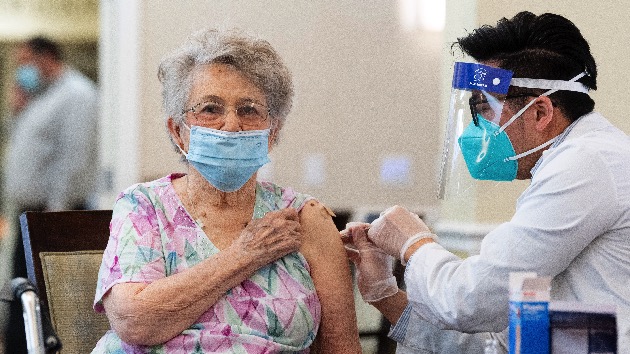Nursing homes struggle with low booster rates, staffing issues as omicron spreads
Paul Bersebach/MediaNews Group/Orange County Register via Getty Images
(NEW YORK) — As the omicron variant causes a surge in coronavirus cases, many long-term care facilities are facing challenges not seen in months, officials from around the country tell ABC News.
Many nursing homes are struggling with low booster rates and a growing staffing crisis, said industry executives and health care advocates.
“Nursing homes are on high alert right now,” said Terry Fulmer, president of the John A. Hartford Foundation, a nonprofit that works to improve care for older adults. “Omicron is highly transmissible and is spreading through communities like wildfire.”
In the week ending Jan. 2, nursing homes and long-term care facilities reported close to 15,000 cases across the country, three times the infection rate from just a month ago when facilities were reporting under 5,000 cases, data released by the Centers for Disease Control and Prevention shows.
Cases among staff members have shot up at an even higher rate, with facilities reporting upwards of 34,000 cases in the week ending on Jan. 2, compared to just over 5,600 a month ago.
In Sussex County, New Jersey, the National Guard was deployed last week to assist nursing home staff with infection control protocols and other duties as multiple facilities saw COVID-19 outbreaks.
“The staff at these facilities have been particularly hard hit by the latest COVID variant,” County Commissioner Anthony Fasano said in a statement. “We believed it was prudent to get them the help they needed before there was a crisis.”
In California, after more than 5,000 new cases were reported in skilled nursing facilities, the state’s public health officer, Tomas Aragon, announced that boosters will be mandatory for health care works and that visitors will require additional testing.
According to the CDC data, the recent spread of the virus among long-term care residents is occurring primarily among unvaccinated and twice-vaccinated residents, while the infection rate remains low for residents that have received a booster shot.
For most adults, two doses of currently authorized COVID-19 vaccines dramatically reduce the risk of being hospitalized or dying of the virus. But elderly adults, whose immune defenses fade with age, may still be at higher risk of serious illness from COVID-19, especially if it’s been more than five months since their last shot.
As of Jan. 2, more than 87% of residents at nursing homes nationwide had received two shots, and nearly 62% had been boosted, according to the CDC data.
For industry advocates, increasing the number of residents and staff getting boosters is a priority.
“We have been urging long-term care providers to get ready and to get ahead of the surge by ramping up their booster efforts,” said Cristina Crawford, a spokesperson for the American Health Care Association/National Center for Assisted Living.
Hartford told ABC News that she’s especially concerned that the rate of booster shots among staff is lagging behind.
“We have to increase our efforts to get boosters into the arms of both residents and staff,” she said.
In Ohio, where around 40% of nursing home staffers remain unvaccinated and the 21-day case average is above 14,000, omicron has “exacerbated” the growing staffing crisis, said Pete Van Runkle, executive director of the Ohio Health Care Association.
“Cases in long-term care in Ohio are about four times as many with omicron as during the height of delta,” Runkle told ABC News.
“The biggest problem with the incredibly high transmissibility is staff missing time from work,” he said.
The good news, said Runkle, is that despite the rising number of cases, nursing homes are reporting “very few” COVID-related deaths compared to last winter’s surge.
Across the country, death rates among long-term care residents and staff have remained flat throughout the spread of omicron. Nationally, facilities have reported 405 deaths among residents in the week ending Jan. 2, compared to 485 deaths in the week ending Dec. 5, according to data released by the CDC.
Pennsylvania state Health Care Association CEO Zach Shamberg said the good numbers are the result of a multi-pronged approach.
“This is a complete 180 from what we have seen last year and is a credit to providers and front-line workers who are doing everything they can to mitigate the spread of the virus now that they better understand the virus, have PPE and tests, and most importantly, access to a vaccine and boosters that help provide an additional level of protection for residents and workers,” Shamberg said.
Copyright © 2022, ABC Audio. All rights reserved.

